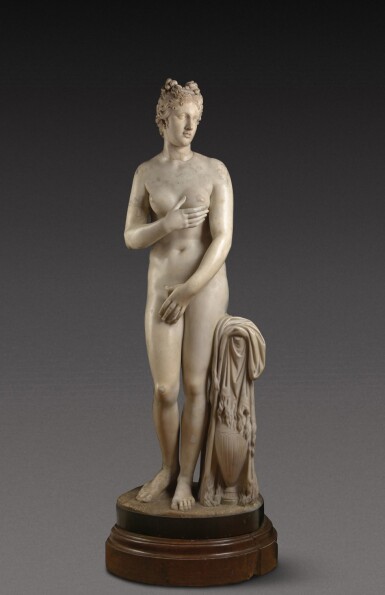Auctions
Buy Now
Collectibles & More
Books & Manuscripts
The Hamilton Aphrodite
The Hamilton Aphrodite

Property formerly in the Collection of the Duke of Hamilton, Hamilton Palace
Auction Closed
December 7, 05:27 PM GMT
Estimate
2,000,000 - 3,000,000 GBP
Lot Details
Description
Property formerly in the Collection of the Duke of Hamilton, Hamilton Palace
A Marble Figure of the Capitoline Aphrodite
over-lifesize, based on a lost Greek statue from the late 4th Century B.C., the goddess standing with the weight on her left leg, the head turned to her left, her wavy hair parted in the center and tied in a top-knot, her ears pierced for earrings, thin struts connecting the fingertips of the left hand to the body; restored in marble are the entire support, the right big toe, the inside of the left foot, the kneecap, the nipples, the right forearm and hand, the front knuckle of the right thumb, and the neck; the head (ancient, but not belonging) with restored chignon, part of the hair on the left side, on the top, and on the back.
Total height 196.8 cm.; height from the top of the ancient base 187 cm.
The painter and art dealer Gavin Hamilton (1723–1798), Rome, acquired in 1775 or shortly beforehand
Douglas Hamilton, 8th Duke of Hamilton and 5th Duke of Brandon (1756–1799), Hamilton Palace, Lanarkshire, acquired from the above in 1776
Archibald Hamilton, 9th Duke of Hamilton and 6th Duke of Brandon (1740–1819), Hamilton Palace, by descent
Alexander Hamilton, 10th Duke of Hamilton and 7th Duke of Brandon (1767–1852), Hamilton Palace, by descent
William Hamilton, 11th Duke of Hamilton and 8th Duke of Brandon (1811–1863), Hamilton Palace, by descent
William Douglas-Hamilton, 12th Duke of Hamilton, 9th Duke of Brandon, and 2nd Duke of Châtellerault (1845–1895), Hamilton Palace, by descent
Spink & Son, Ltd., London
William Randolph Hearst (1863–1951), International Studio Art Corporation, inv. no. 6-30-39 (at the Bronx Warehouse in 1933), acquired from the above on June 15th, 1920
Joseph Brummer (1883–1947), New York, inv. no. N4623, acquired from the above on August 15th/16th, 1940
Parke-Bernet Galleries, New York, The notable art collection belonging to the estate of the late Joseph Brummer. Part III, June 8th-9th, 1949, no. 492, illus.
private collection
private collection, by descent to the present owner
DOCUMENTATION The present statue is mentioned:
-in a letter by Gavin Hamilton to Lord Shelburne, 16 April 1775 (I. Bignamini and C. Hornsby, Digging and Dealing in Eighteenth-Century Rome. Letters, 2010, p. 65: "[...] the one [sc. Venus] I have [...] being the size of that in the Capitol, and the same in every other respect");
-in a letter by Hamilton to Lord Shelburne, 30 May 1775 (Bignamini and Hornsby, op. cit., p. 68: "The Venus I have, though of excellent sculpture and all antique excepting a vase thrown with drapery upon it [...]");
-in a letter by Hamilton to Charles Townley, 17 December 1775 (Bignamini and Hornsby, op. cit, p. 80: "[...] my large Venus [...] the head of the finest in the world is not its own");
-in a letter by Hamilton to Townley, 30 December 1775 (Bignamini and Hornsby, op. cit., p. 80f.: "The Duke of Hamilton has purchased the Venus");
-in a letter by Hamilton to Lord Shelburne, 6 January 1776 (Bignamini and Hornsby, op. cit., p. 81: "The large Venus I had in my possession is now on its way to Scotland. The Duke of Hamilton fell in love with it the moment he saw it, and secured it immediately. It is a fine thing");
-in a letter by Hamilton to Townley, 10 February 1776 (Bignamini and Hornsby, op. cit., p. 83: "The Venus you mention is now the property of the Duke of Hamilton");
-in the 1852/1853 Hamilton Palace Inventory, Hamilton Archive, Lennoxlove, vol. 1228, p. 132, https://archive.vhpt.scot/imageview/1908 (as "The magnificent antique marble figure of Venus, bought by Duke Douglas, with The black marble massive Pedestal with machinery for the marble statue of Venus to revolve on").
PUBLISHED
Gustav F. Waagen, Treasures of Art in Great Britain, vol. 3, London, 1854, p. 296
Adolf Michaelis, Ancient Marbles in Great Britain, Cambridge, 1882, p. 300, no. 1
Spink & Son, London, Exhibition of ancient sculpture, vases, and bronzes. Illustrated supplement containing late acquisitions from the Hamilton Palace and Singleton Abbey Collections, 1920, no. 76, illus. (Incorrectly given the same provenance as that of the Barberini/Jenkins Venus)
Cornelius C. Vermeule, "Notes on a new edition of Michaelis: Ancient Marbles in Great Britain," American Journal of Archaeology, vol. 59, 1955, p. 135f.
For the Capitoline Aphrodite type see S. Kansteiner, in K. Stemmer, ed., In den Gärten der Aphrodite, exh. cat., Berlin, 2001, p. 107f., no. G1. The restored support reproduces the ancient one of the eponymous copy. This is also the case with copies in Berlin (Antikensammlung Sk 29: https://arachne.dainst.org/entity/1120968), and in the Louvre (Ma 373: https://collections.louvre.fr/ark:/53355/cl010277376).
Dispersed marbles from Hamilton Palace include a bust of the Knidian Aphrodite (Michaelis, op. cit., p. 300, no. 2; C. Blinkenberg, Knidia, 1933, pp. 180ff., no. V1), now in the British Museum, inv. no. 1924, 1115. 1, and a figure of a togatus (Michaelis, op. cit., p. 301, no. 8; Vermeule, op. cit., p. 135), now in the Memorial Art Gallery, Rochester, New York, inv. no. 73.146. The whereabouts of the other two statues formerly at Hamilton Palace, a figure of Apollo (Parke-Bernet, New York, December 7th-8th, 1951, no. 19, also from Spink and William Randolph Hearst) and a figure of Paris (Anderson Art Galleries, New York, January 26th 29th, 1921, no. 798), remain unknown, as indeed was the case for the present statue until recently.